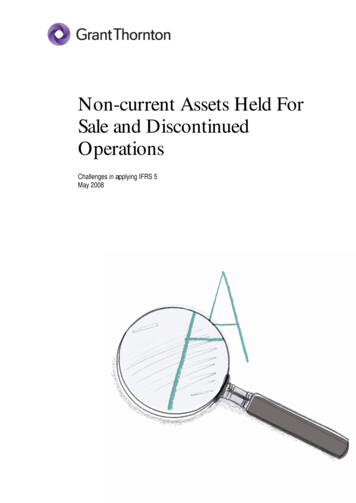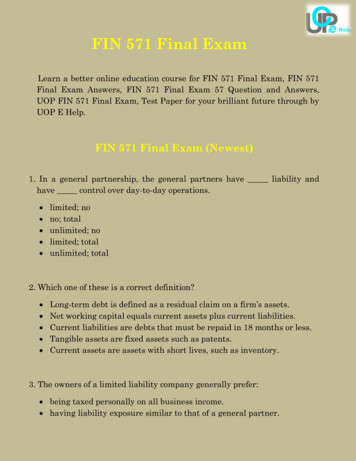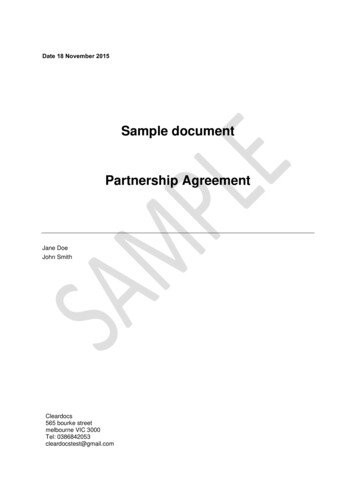
Transcription
Non-current Assets Held ForSale and DiscontinuedOperationsChallenges in applying IFRS 5May 2008
Challenges in applying IFRS 51IntroductionDiscontinuing a business operation or deciding to sell a major asset are important commercialevents. These decisions are also likely to have a significant effect on an entity's results and netassets. The impact of these events and the way in which they are reported is therefore of muchinterest to investors, analysts, regulators and other financial statement users. This is also the subjectof a specific International Financial Reporting Standard: IFRS 5 Non-current Assets Held for Sale andDiscontinued Operations (IFRS 5).IFRS 5 can have a significant effect on a company's profit or loss, the carrying values of its assetsand on the presentation of results. The financial statement impacts may extend to prior and futureaccounting periods. IFRS 5 is not a new standard but experience has shown that implementationcan be a complex and time-consuming exercise. Significant judgment is required in some areas.Management and auditors should therefore assess the impact of IFRS 5 as soon as they becomeaware that it may be relevant.The member firms within Grant Thornton International Ltd (Grant Thornton International) - oneof the world's leading organisations of independently owned and managed accounting andconsulting firms - have gained extensive insights into the more problematic aspects of IFRS 5.Grant Thornton International, through its IFRS team, develops general guidance that supports itsmember firms commitment to high quality, consistent application of IFRS and is therefore pleasedto share these insights by publishing this guide Non-current Assets Held for Sale and DiscontinuedOperations. The guide reflects the collective experience of Grant Thornton International's IFRS teamand member firm IFRS experts. It explains IFRS 5's key implementation issues and commonapproaches to practical application. The guide also includes several examples illustrating theStandard's disclosure and presentation requirements.The guide is organised as follows:Section A addresses when assets (and related liabilities) are classified as held for sale ;Section B sets out the circumstances in which a planned or completed disposal gives rise to adiscontinued operation ;Section C covers the measurement consequences of held for sale classification;Section D provides guidance on the application of IFRS 5's requirements on presentingdiscontinued operations and assets held for sale and related disclosures; andSection E provides specific guidance on many of the common practical and interpretive issuesencountered in applying IFRS 5. 2008 Grant Thornton International Ltd All rights reserved.
Challenges in applying IFRS 5References to IAS 1 Presentation of Financial Statements (revised 2007)All references in this guide to IAS 1 are based on the 2007 version of this standard. Therevised version of IAS 1 introduced, amongst other amendments, various changes in thefinancial statement terminology. For example, IAS 1 uses the term statement of financialposition instead of balance sheet and statement of cash flows instead of cash flowstatements . This guide reflects these recent changes to the IFRS terminology. 2008 Grant Thornton International Ltd All rights reserved.2
Challenges in applying IFRS 53ContentsPageIntroduction1A. Assets held for sale and disposal groups51. Definitions52. Initial classification requirements62.1 Available for immediate sale62.2 Highly probable sales transaction73. Allocating assets and liabilities to a disposal group4. Subsequent review of the held for sale classification9124.1 Conditions are imposed as expected on the transfer of assets124.2 Conditions are unexpectedly imposed on the transfer of assets124.3 Buyer not found during initial one-year period13B. Discontinued operations141. Definitions142. Classifying business activities as discontinued operations152.1 Significance of the ceased activities152.2 Manner and timing of disposal152.3 Discontinued operations and held for sale classification15C. Measurement requirements of IFRS 5171. Measurement scope of IFRS 5172. Measurement of asset(s) held for sale182.1 Fair value less costs to sell182.2 Recognition of impairment losses192.3 Reversals of previous impairment losses203. Measurement implications of a change in or withdrawal from the selling planD. Presenting discontinued operations and assets held for sale, and related disclosurerequirements1. Assets held for sale and disposal groups: Presentation and disclosures2124241.1 Presentation in the statement of financial position241.2 Disclosures252. Discontinued operations: presentation and disclosures2.1 Presentation in the statement of comprehensive income 2008 Grant Thornton International Ltd All rights reserved.2626
Challenges in applying IFRS 542.2 Comparatives262.3 Disclosures272.4 Cash flows resulting from discontinued operations273. Changes in a plan to sell284. Post-disposal results from discontinued operations285. Example presentation layouts and selected explanatory notes thereto285.1 Assets held for sale and disposal groups285.2 Discontinued operations31E. Practical implementation issues351. Assets acquired exclusively with a view to resale351.1 Held for sale classification351.2 Consolidation of a subsidiary acquired exclusively with a view to resale351.3 Initial measurement361.4 Financing costs and income taxes361.5 Presenting discontinued operations361.6 Disclosures362. Part-disposal of a subsidiary373. Separate financial statements374. Measurement of liabilities associated with a disposal group375. Intragroup transactions and balances386. Related disclosure requirements in other IFRSs386.1 Assets held for sale386.2 Discontinued operations39 2008 Grant Thornton International Ltd All rights reserved.
Challenges in applying IFRS 55A. Assets held for sale and disposal groupsIFRS 5 sets out specific measurement requirements for non-current assets and disposal groups thatare classified as held for sale . Held for sale classification is not an accounting policy choice; it ismandatory when certain conditions apply, namely if the asset(s) in question is (are) available forimmediate sale and the sale is highly probable. Very often, a planned sale involves a group of assets(and possibly liabilities). IFRS 5 introduces the concept of a disposal group to address thissituation.This section discusses the requirements to meet the held for sale classification. The measurementrequirements that apply when this classification takes effect are discussed in Section C.1. DefinitionsIFRS 5.6 states that:An entity shall classify a non-current asset (or disposal group) as held for sale if its carrying amount will berecovered principally through a sale transaction rather than through continuing use .Typically, this definition captures individual assets that the entity seeks to dispose of in a saletransaction, such as:Property, plant and equipment;Intangible assets;Investment property,Biological assets; andNon-current financial investments, such as interests in associates, or other financial instruments.Assets that are to be abandoned or scrapped (rather than sold) are not classified as assets held forsale (IFRS 5.13-14). Assets that will be derecognised due to an exchange of non-current assets witha third party are covered by IFRS 5 unless the exchange lacks commercial substance. Sale andleaseback transactions are outside the scope of IFRS 5 and are covered by IAS 17 Leases. Sales ofmachinery, vehicles and other equipment, which have been replaced by new items, and sales ofsurplus property are very common examples of transactions where IFRS 5 applies even where thedisposed assets do not form a disposal group. 2008 Grant Thornton International Ltd All rights reserved.
Challenges in applying IFRS 56A disposal group is defined as:A group of assets to be disposed of, by sale or otherwise, together as a group in a single transaction, andliabilities directly associated with those assets that will be transferred in the transaction. The groupincludes goodwill acquired in a business combination if the group is a cash-generating unit to whichgoodwill has been allocated in accordance with the requirements of paragraphs 80 87 of IAS 36Impairment of Assets (as revised in 2004) or if it is an operation within such a cash-generating unit(IFRS 5.A).Hints- An abandonment orunintentional loss ofcontrol over assets doesnot meet the held for saleclassification.- Assets that are sold in aseries of transactionsrather than in a singletransaction need to beconsidered individually todetermine whether or notthey should be classifiedas held for sale.Examples of a disposal group include a subsidiary or an operating segment or a cash generating unit(CGU). A disposal group is sometimes but not always a discontinued operation (see page 15).2. Initial classification requirementsIFRS 5 specifies two main requirements to initially classify asset(s) as held for sale. Firstly, theasset(s) must be available for immediate sale in its (their) present condition. Secondly, the sale mustbe highly probable.2.1 Available for immediate saleThe term available for immediate sale requires some interpretation. An asset is available forimmediate sale if there is no significant reason why the sale could not take place immediately.Terms that are usual and customary for similar sales and are not likely to cause a material delay donot preclude held for sale classification.The Implementation Guidance to IFRS 5 sets out a number of examples to illustrate these concepts.Assets are not available for immediate sale if they continue to be needed for the entity's ongoingoperations (IFRS 5.IG examples 1b and 2b) or are being refurbished to enhance their value(IFRS 5.IG example 3a). Held for sale classification is then delayed until the assets under review areavailable for immediate sale.Examples1A property used as headquarters by the entity itself needs to be vacated before it can be sold.If the property is expected to be vacated in the usual course of the sales plan, then a held forsale classification may be appropriate in accordance with the standard. If however theproperty can be vacated only after a replacement is available (eg a new building underconstruction or one that still needs to be vacated by its former tenants/owners), then this mayindicate that the property is not available for immediate sale, but only after the replacementbecomes available.2An entity intends to sell a manufacturing facility. If the entity needs the facility to clear abacklog of uncompleted orders, then this may indicate that the facility is not available forimmediate sale. If the entity however seeks to sell the manufacturing facility including thebacklog of uncompleted orders, its availability for immediate sale may be assumed.3An entity plans to renovate some of its property to increase its value prior to selling it to athird party. The entity is already searching for a buyer at current market values. Nevertheless,due to the plans to renovate the property prior to sale, the property may not be available forimmediate sale. 2008 Grant Thornton International Ltd All rights reserved.
Challenges in applying IFRS 572.2 Highly probable sales transactionFor a sale to be highly probable at the reporting date, the entity must have a plan to sell. There areno specific requirements regarding the sale s form and judgement is required to determine whetherthe conditions in IFRS 5 have been met.Sometimes a potential buyer may already have been identified and the selling plan is thereforereasonably apparent at the reporting date. Indeed, the trigger for a held for sale classification isoften a buyer s firm purchase commitment a contract that IFRS 5 defines as:An agreement with an unrelated party, binding on both parties and usually legally enforceable, that(a) specifies all significant terms, including the price and timing of the transactions, and (b) includes adisincentive for non-performance that is sufficiently large to make performance highly probable. (IFRS 5.A)The substance of any arrangement between the selling entity and the probable buyer needs toconsidered. A letter of intent or similar pre-contract document may or may not constitute a firmcommitment for this purpose. The enforceability of the arrangement needs to be assessed and maydepend in part on the legal environment in addition to the stated terms. Pre-contract arrangementsmay or may not specify a penalty if one of the parties withdraw from the transaction.In the absence of a firm sales commitment, further analysis of the selling plan is necessary todetermine whether the anticipated transaction is highly probable. IFRS 5 sets out five conditionswhich need to be met:Five conditions of a highly probable sales transaction (IFRS 5.8):The appropriate level of management is committed to the selling plan;The asset(s) are being actively marketed;The assets are on the market at a price that is reasonable in relation to their estimatedcurrent fair values;Completion of the sales transaction is expected within one year from the initial date ofclassification; andSignificant changes to or a withdrawal from the selling plan are unlikely.Consideration of whether these conditions have been met is based on the specific facts andcircumstances and professional judgement is necessary to determine whether a salestransaction is highly probable.Commitment by appropriate level of management (and related shareholder approval)The appropriate level of management should be committed to the selling plan (IFRS 5.8).Management is generally regarded as those persons with authority and responsibility for planning,directing and controlling the activities of the entity. A sale cannot usually be considered highlyprobable if the entity s management is not (yet) committed to a selling plan.In our view, the entity should also consider whether shareholder approval is required to proceedwith a selling plan. Shareholder approval is, for example, sometimes necessary under applicable lawsor regulations. In some circumstances, shareholder approval might be a perfunctory matter.However, the sale will not be highly probable if shareholder approval is substantive and there isreasonable doubt that it will be forthcoming. 2008 Grant Thornton International Ltd All rights reserved.
Challenges in applying IFRS 58Active marketing effortsFor a selling plan to indicate a highly probable sale, an active programme to locate a buyer andcomplete the plan must have been initiated (IFRS 5.8). The entity therefore must actively marketthe asset(s) by making its intention to sell known to third parties that may be interested in acquiringthe asset.In practice, the engagement of an outside selling agent to attract interest from potential buyers maybe considered as an active marketing effort by the entity. Advertisement of the intention to sellthrough the media may also be considered as the beginning of active marketing efforts. However, itis generally not necessary to announce the intention to sell to the general public or to employees ofthe entity that are likely to be affected by the sales transaction.If an entity initiates a sale programme after the reporting date but before the date of authorisation ofthe financial statements, presenting an asset(s) as held for sale is precluded. However, it may benecessary to disclose a non-adjusting event after the reporting date in accordance with IAS 10 EventsAfter the Reporting Period.Marketed at fair valueThe asset(s) must also be marketed at a suggested selling price that is reasonable compared to its fairvalue (IFRS 5.8). This does not necessarily require that the asking price is announced to potentialbuyers. Sometimes an asking price that exceeds fair value is announced, based on an expectationthat the actual price will be reduced to fair value in negotiation. This does not preclude the held forsale classification if the difference is justifiable based on local market conditions.Sale or firm purchase commitment highly probable within one-year periodAt the date of initial classification of one or more assets as held for sale it should be reasonable toexpect that the selling plan is completed within one year (IFRS 5.8). In our view, a selling plan iscompleted only when the assets (and liabilities if applicable) qualify for de-recognition in accordancewith applicable IFRS.This requirement for aheld for saleclassification needs to beconsideredindependently from theright to sell the assetsunder review. If a sale isnot possible eg due tophysical constraints,immediate availability forsale should not beassumed andclassification of theasset(s) as held for saleis not appropriate.The only exception to this one year timeframe arises in circumstances in which the entity expects anoutside party (not the buyer) to impose conditions on the transfer of assets that will extend theperiod to complete the sale (eg regulatory approval). Held for sale classification is then appropriateif the entity can address the imposed conditions only after a firm purchase commitment has beenobtained and if a firm purchase commitment is highly probable within one year (IFRS 5.9 andIFRS 5.B1 (a)).Other factors to consider in assessing the probability of a sale within one year include the number ofpotential buyers, the nature and value of the asset in question (including the extent to which it hasspecialised use), market conditions and past experience in selling similar assets.Sales transaction progressing according to planActions taken to complete the selling plan and events since the held for sale classification wasinitiated should indicate whether or not the sale is likely to occur according to plan. If there areindicators that significant changes to the selling plan will be necessary or if a withdrawal from theselling plan is likely, the sale should not be considered highly probable and hence, the asset(s) underreview should not be classified as held for sale (IFRS 5.8). Indicators that should be consideredinclude a downturn in the relevant market sector, increases in interest rates (which affect financingcosts of a potential buyer) and changes in the business strategy of the reporting entity. 2008 Grant Thornton International Ltd All rights reserved.
Challenges in applying IFRS 593. Allocating assets and liabilities to a disposal groupIf the entity s sales plan addresses a group of assets that will be disposed of in a single transaction,the entity classifies the group of assets as a whole as held for sale. It also presents any liabilitiesassociated with those assets as held for sale, if the liabilities will be transferred in the sametransaction. Any goodwill directly allocated to the group of assets to be disposed of is also treatedas held for sale. This includes sales of all or part of a CGU to which goodwill has been allocated.These assets and the related liabilities are then referred to as a disposal group .IFRS 5 does not provide further detailed guidance on which assets or liabilities should be includedin a disposal group. The definition above (page 6) suggests that a disposal group includes only thoseassets and liabilities that will be disposed of in the single planned sales transaction. In addition toidentifying common types of non-current assets (see page 5) which should be included in thedisposal group, the following points should be considered in order to determine whether otherindividual assets and liabilities may be allocated to a disposal group:The intention to carry out the sale cash and debt free indicates that cash and cash equivalentsas well as some of the group s financial liabilities may not be part of the sales transaction;Deferred taxes recognised in connection with the assets and liabilities of a disposal group shouldbe included in the disposal group. The same principle applies to unused tax losses and unusedtax credits that will be transferred to a third party in the course of the anticipated salestransaction; andAll liabilities expected to be transferred to a third party in the course of the single salestransaction should be included in the disposal group. This may include, in particular, non-currentliabilities such as provisions or employee benefits obligations.Deferred tax assets and liabilitiesA careful analysis is necessary to assess whether deferred taxes are directly associated with adisposal group, ie they will be transferred in the anticipated sales transaction:Temporary differences that directly relate to assets and liabilities inside the disposalgroup (sometimes referred to as inside basis differences ) give rise to deferred taxes thatbelong to the disposal group.In group tax structures, temporary differences may also arise in connection with theinterest in the disposal group, but outside of the level of the investing entity. Theseoutside basis differences should not be included in the disposal group, as they willtrigger tax payments for the continuing part of the reporting entity.Consideration of these matters should be based on the specific facts and circumstances andprofessional judgement is often required to determine whether deferred taxes are directlyassociated with a disposal group or not. 2008 Grant Thornton International Ltd All rights reserved.
Challenges in applying IFRS 510Differing interpretations can arise as to how current assets should be allocated to a disposal group.Two approaches are applied in practice, which both appear acceptable under IFRS 5.One approach would be to focus on the definition of the disposal group. This definition refers toassets that will be disposed of, by sale or otherwise, together as a group in a single transaction(IFRS 5.A). This appears to exclude assets and liabilities that will no longer exist at the expecteddate of this single transaction because they have been sold, transferred, realised or settled before thatdate. Where the disposal group represents a CGU, subsidiary or similar unit of the entity, ananalysis of its current assets and liabilities is therefore necessary to exclude items not expected to bepart of the single sales transaction. Related deferred tax assets and liabilities also need to beexcluded.Another approach focuses on IFRS 5.4, which states that a disposal group may include any assetsand any liabilities of the entity including current assets . This approach leads to the inclusion of allof the categories of asset and liability expected to be disposed of in the single transaction. It doesnot look to the individual assets and liabilities within those categories. All current assets andliabilities that can be allocated to the disposal group at the reporting date are therefore included inthe disposal group without further analysis. 2008 Grant Thornton International Ltd All rights reserved.
Challenges in applying IFRS 511Example: Allocating assets and liabilities to a disposal groupEntity A currently controls subsidiary B for which it is actively seeking a buyer. The subsidiary isavailable for immediate sale and the sale is considered highly probable. In the consolidatedaccounts of the A-group, the following assets and liabilities are held and assumed by B:AssetsGoodwillOther intangible assetsProperty, plant and equipmentInventoryTrade ilitiesLong term borrowingsEmployee benefit obligationsOther provisionsDeferred taxesTrade payablesCU000s1,0001,2004003503003,250Entity A is currently considering offers for subsidiary B and expects that the sales transaction willbe completed in 5 months. Current discussions focus on a sale of the subsidiary cash and debtfree, so its long-term borrowings and the cash held directly by subsidiary B are not considered tobe part of the disposal group.An analysis of deferred tax liabilities shows that they are mainly related to temporary differencesarising in conjunction with intangible assets and subsidiary B s property, plant and equipment. Itis therefore concluded that the deferred tax liabilities should be included in the disposal group.Entity A expects that all of the inventories, trade receivables and trade payables will be sold orsettled within the next five months. As discussed above, it is therefore an interpretation issue asto whether these current items are included or excluded from the disposal group. In this case,Entity A has made an accounting policy choice in a previous transaction to include all assets andliabilities in a disposal group based in the circumstances at the reporting date. Its disposal groupassets and liabilities may therefore be summarised as follows:Disposal group assetsGoodwillOther intangible assetsProperty, plant and equipmentInventoryTrade receivablesCU000s5008001,2003004003,200Disposal group liabilitiesEmployee benefit obligationsOther provisionsDeferred taxesTrade payables 2008 Grant Thornton International Ltd All rights reserved.CU000s1,2004003503002,250
Challenges in applying IFRS 5Review within the initialone-year periodWithin the one-yearperiod, the classificationis continued if all theinitial classificationrequirements of IFRS 5.8are still met. If the assetsare no longer availablefor immediate sale or if asales transaction is nolonger highly probable,the classification is to beceased. The entity thenneeds to reclassify theassets in accordancewith applicableIFRS (IFRS 5.26) andmodify the measurementof the asset(s) underreview in accordancewith IFRS 5.27-29.124. Subsequent review of the held for sale classificationSales transactions may sometimes not proceed as initially planned, for example, where a buyercannot be found or regulatory approval is required. A review of the selling plan is generallynecessary at subsequent reporting dates to ensure that the held for sale criteria continue to be met.If the sales transaction is delayed beyond the initial one-year period, it is necessary to consider thereasons for the delay. IFRS 5 allows an extension of the held for sale classification only if thedelay is caused by events or circumstances beyond the entity s control and there is sufficientevidence that the entity remains committed to its plan to sell the asset (or disposal group)(IFRS 5.9). The standard identifies only three scenarios in which a delay is considered to be beyondthe entity s control and the held for sale classification may be continued (provided that the salestransaction is still highly probable and that the asset(s) is (are) still available for immediate sale).4.1 Conditions are imposed as expected on the transfer of assetsThe selling entity has obtained a firm purchase commitment at the end of the initial one-year period.As initially expected, a party other than the potential buyer has imposed conditions on the transferof the asset(s). This outside party may, for example, be a regulatory body such as a governmentanti-trust agency or similar oversight body and actions necessary to respond to these conditionscould not be initiated until a firm purchase commitment from a potential buyer was obtained. Asthe selling entity is dealing with the imposed conditions, completion of the sales transaction isexpected after more than one year since the initial held for sale classification.The held for sale classification is continued in this scenario if actions to respond to conditionsimposed on the transfer of assets have been initiated (IFRS 5.B1 (a)).4.2 Conditions are unexpectedly imposed on the transfer of assetsThe potential buyer or another party has imposed conditions on the transfer of assets that will delaycompletion of the selling process. The conditions were not expected at the initial classification date.The entity, however, has obtained a firm purchase commitment. In this scenario, the asset(s) onlycontinue to be classified as held for sale if:The entity has taken timely actions to respond to the conditions (IFRS 5.B1 (b) (i)); andIt is expected that the delaying factors will be resolved to allow completion of the selling plan(IFRS 5.B1 (b) (ii)). 2008 Grant Thornton International Ltd All rights reserved.
Challenges in applying IFRS 5IFRS 5 is not entirelyclear on whether theinitial one year periodmay be extended onlyonce, or more often. Inpractice, repeated delaysare in any case likely tocast significant doubt onthe completion of thesales transactionaccording to plan.134.3 Buyer not found during initial one-year periodOther events that were not considered likely at the date of initial classification resulted in a delaybeyond the one year period. Examples include circumstances in which the relevant market hasunexpectedly dried up or where the asset(s) concerned have rapidly lost their appeal to potentialbuyers due to technological obsolescence or similar developments.In this scenario, the selling entity may only continue to classify the asset(s) concerned as held forsale if the delay is due to developments outside the entity s control. Factors to consider in thesecircumstances include:Whether the entity took the action during the initial one-year period that was necessary torespond to changes in circumstances that were initially considered unlikely, but that in factcontributed to the delay (IFRS 5.B1 (c) (i)).Whether the asset(s) were actively marketed at a price reasonable given the changes incircumstances (IFRS 5.B1 (c) (ii)). In practice, the entity should have contacted either directly orindirectly through a selling agent potential buyers and conducted reasonable effort to completethe sales transaction.Whether a sale is still considered highly probable and the asset(s) continues to be available forimmediate sale in its current condition (IFRS 5.B1 (c) (ii)).Where the asset(s) concerned have been damaged in the meantime or are used again in the entity scontinuing operations, this may indicate that they are not available for immediate sale and the heldfor sale classification should cease. 2008 Grant Thornt
For example, IAS 1 uses the term statement of financial . Held for sale classification is not an accounting policy choice; it is mandatory when certain conditions apply, namely if the asset(s) in question is (are) available for . Sale and leaseback transactions are outside the scope of IFRS 5 and are covered by IAS 17 Leases. Sales of











